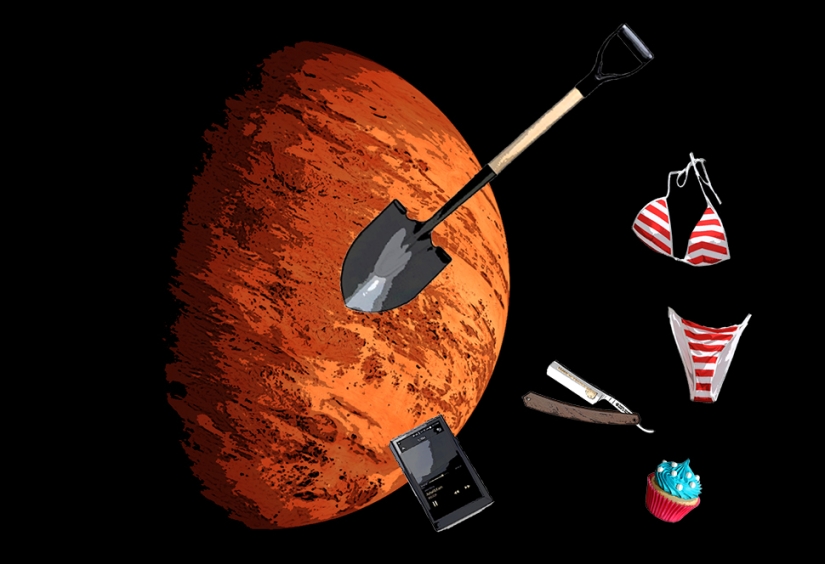Earthly things in space: what to take to another planet
Categories: Space | Technology
By Pictolic https://pictolic.com/article/earthly-things-in-space-what-to-take-to-another-planet.htmlHumanity is obsessed with the idea of creating settlements outside the Earth. What the Mars One expedition is worth. This is a private project that involves the establishment of a colony on the Red Planet. The life of the settlers will be broadcast on television. In 2013, the founders of the project began selecting astronauts for the first crew. Now the third qualifying round is taking place and the number of candidates is 660 people.
Everything connected with the cosmos seems to ordinary people too unattainable to associate it with at least some earthly things. We are sure that technological progress has reached a height almost as exorbitant as the distance from Earth to Mars is. Therefore, we decided to look for equipment, products and devices that you can already buy in stores and take with you on an expedition to another planet.
Our first hero is an audiophile's dream, the Astell&Kern AK300 player, which can well be called cosmic. We explain why.
(10 photos in total)

We took a chance — we decided that the player is really cool and can be used in space travel not only as an entertainment device. We read the technical description, found a lot of useful things. Some of them tried to adapt to the tasks of the first large-scale expedition to Mars.
Graphic equalizer will help in ear training

To say that supermen are being selected for the expedition is to say nothing. By the start, astronauts must master a lot of skills, among which is the repair of technical equipment: identifying problems and quickly eliminating them. Two astronauts from the first group will definitely receive thorough medical training, one will explore the geology, another one — the exobiology of the planet. The rest of the necessary skills will be shared by all crew members. In addition to theoretical knowledge, new space researchers will not be hindered by trained external senses, including hearing.
Astell&Kern AK300 has an incredible graphic equalizer for terrestrial reality. It divides sound frequencies into several registers: increases or decreases the level of each register depending on the volume to adjust the characteristics of the corresponding frequency. The volume control switches are displayed on the device display for visual determination of frequency characteristics, hence the name "graphic".

This player has 20 tracks at once. It is logical to assume that it will reproduce the details of the same audio file in different ways. A high-quality sound recording of some process (for example, the sound from a busy city street, the sound of a running engine) can be an excellent help for ear training. With the help of the equalizer, we change the registers and make the individual sounds of the process "quieter". An astronaut must strain his ears to hear what a street vendor is shouting from a recording, for example.
Storing audio information about the planet

Based on the low density of the Martian atmosphere, it can already be assumed that sound will spread poorly there. However, American scientists have performed a numerical experiment that allowed us to describe the journey of sound on Mars in more detail and accurately. They filled a virtual box with a virtual atmosphere in the amount of 10 million carbon dioxide molecules (the main component of the atmosphere of the Red Planet), the movement of each of which was calculated by a computer. The simulated sound wave passed from one end of the box to the other. The computer showed that a loud sound, which on Earth would easily travel a distance of several kilometers, would completely die down on Mars after passing several tens of meters. Even the high-pitched squeal of a gasoline lawn mower there would be completely inaudible after 100 meters, the authors of the study claim.

If you need to listen to some recordings after people start landing on the planet, and this will happen very soon according to the Mars One program, you will need a device that will reproduce the recording with the smallest details for further research. This device may well become Astell & Kern. And all thanks to the ability to play PCM. The Pulse Code Modulation format is the most complete source of sound information, the standard of sound representation. An audio track in PCM format can be an exact copy of the original studio encoded on a disc without compression.
Amplifier for sound notification

On Mars, such a phenomenon as dust vortices ("dust devils") is common. They were first photographed during the Viking program in the 1970s. In 1997, another automatic Martian station recorded the passage of a dust vortex directly above it. Martian dust vortices can be up to 50 times wider and up to 10 times higher compared to terrestrial ones. Particularly large dust vortices can pose a threat to automatic Martian stations and rovers.

The AK300 provides studio-quality audio playback, it is equipped with high-precision femtocells and a parametric 20-band equalizer. The player supports the USB-DAC function when connected to computers on a PC or Mac platform — at the output of the AK300 we receive an audio signal with characteristics of 24 bits / 96 kHz, which will provide accurate sound in headphones, speakers or a speaker system. That is, if we take the sound receiver outside of some Martian module, and Astell & Kern use a USB DAC for an audio broadcasting system, this will be an additional way to learn about an approaching sandstorm. And will help the crew to take the necessary measures.
Wear-resistant

As an additional reason to take this incredibly attractive musical friend into space, it must be said that Astell & Kern is made of aluminum, which guarantees its durability. And only durable things should be taken into space.
Cool music among the stars

The last passage, as usual, is aesthetic. During the long flight to Mars, astronauts are waiting for hours of work and research. There won't be much free time, but still a couple of hours for "meditation", most likely, there will be. It is at these moments that it seems the most correct to use the Astell&Kern AK300 for its intended purpose: just listen to good music while looking at your home planet and the boundless expanses of space.

Keywords: Astronauts | Mars | Music | Partner post | Hearing
Post News ArticleRecent articles

Reddit users gathered once and let's brag about who and what they treat in school canteens. Both the students themselves and their ...

What kind of wedding traditions do not happen! The Scots pour dirty slush over the bride, some peoples of India have decided to get ...
Related articles

Photos of Madonna did not go from the pages of tabloids and magazines for more than 40 years — the public consistently and ...

In the 90s, The Viper Room nightclub was a favorite place of entertainment for many stars. In 1993, it was created by Johnny Depp ...

In 1952, in Mexico, among the ruins of the ancient Mayan city of Palenque, was discovered a tomb with the remains of a man, the ...

The winter sky sometimes presents phenomena that seem almost unreal. Pearlescent, or nacreous, clouds are rare guests in our ...